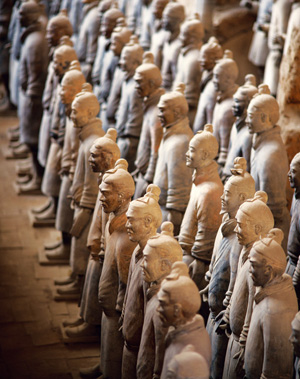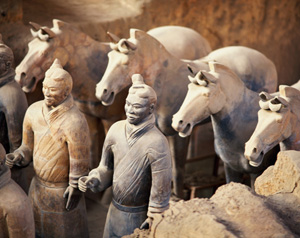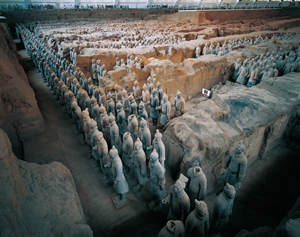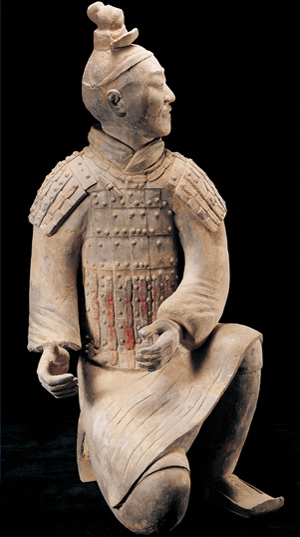Written by: Feng Yang
Posted on: December 31, 2012 |  | 中文
| 中文
The Mausoleum of Emperor Shihuang (259-210 BC) of the Qin Dynasty (221-207 BC) lies at the foot of Mount Lishan, 20 km to the north of Xi'an, capital of Sha’nxi Province in North-west China. "Shihuang" means the "first emperor" and the occupier of the mausoleum was indeed the "first". He unified China when he was 39 years old and made himself the first emperor of the Qin, China's first feudal dynasty. The dynasty, however, was short-lived. It survived for only 15 years. Historians attribute its collapse to the harsh government under his reign, a fact to which this mausoleum may testify.
 |
The original height of the emperor's tomb was 115 m, according to historical records. What we can actually see, however, is just an earthen mound. Archaeological surveys show that the mausoleum should cover an area of 56.25 square km, larger than any other imperial mausoleum in the world, and that the four sides of the area should each measure 7.5 km in length. Two walls of rammed earth once surrounded the mound, the inner wall being 3,870 m in circumference and the outer wall, 6,321 m. The walls are gone, but the ruins of some sections and the foundations testify to their existence some 2,000 years ago.
Archeologists believe that inside the once walled mausoleum, there must have been a whole array of palace halls, supposedly serving the needs of the emperor in the netherworld. These were exactly the same, in size and grandeur, as the halls the emperor had used before he died. Like the walls, the palace structures have all perished.
Beside the foundations of the ruined walls, archeologists found 600 pits with burial objects in them in the mausoleum area. Some pits are actually tombs, in which people were buried alive.
From one of the pits, two large bronze horse-drawn carriages were unearthed. These are copies of the imperial traveling outfits. There are also two pits in which skeletons of hundreds of real horses were found. They were ‘imperial stables’ in the netherworld. A total of 17 pits were found full of the skeletons of wild animals and birds, forming an imperial hunting ground. Stone armor suits were found in the largest pit discovered so far in the mausoleum area. A group of pottery acrobats were found in another pit, supposedly to entertain the dead emperor.
 |
What merit special mention, however, are those tombs and pits in which people were buried alive. According to historical records, builders of the mausoleum were buried alive in the thousands to prevent divulgence of the secret about the life of the emperor in the netherworld. Also buried alive were the emperor's concubines. In 17 tombs, human skeletons are found broken, with bones scattered here and there. The size of these tombs and the coffins and the burial objects in them suggest that the tombs belong to the dynasty's nobles. But the gruesome scenes in the tombs lead to the conjecture that the occupiers of the tombs could be princes who were killed in power struggles.
The emperor is buried beneath the mound, in the Underground Palace as people call it, which is yet to be excavated.
According to the historical records, the Underground Palace is extremely large in size. Its dome is painted with astronomic diagrams of jewels and precious stones. On the floor, there are imitations of rivers, lakes and seas filled with mercury in lieu of water which, driven by some mechanic device, keep flowing. There are also miniature landscapes, as well as halls that are lit by lamps of fish oil, where the dead emperor supposedly gives imperial audience. The underground palace is fitted with concealed weapons to kill anyone who breaks in. Back in the 1980s, scientists tested samples of soil in the mausoleum area, and found that a part of it, 12,000 square meters large, has exceptionally high mercury content. The discovery may prove that there are rivers and lakes of the liquid metal in the Underground Palace.
 |
Construction of the mausoleum started in 246 BC, before the ‘first emperor’ unified China. He was then 13-years old, and had just been enthroned as king of the Qin Kingdom. As many as 700,000 people were working on the construction site at the peak of the 39-year construction. It has to be remembered that China had a population of 20 million at the time.
The most famous of all objects unearthed from the mausoleum area, are of course, those life-sized terracotta warriors and battle steeds. This terracotta army was discovered in March 1974, by some farmers digging a well.
The terracotta warriors are in three pits, which are about five meters deep, with weight-supporting walls three meters high and floors paved with black bricks.
Pit No. 1 is the largest of the three. It is 230 m long and 62 m wide, covering 14,000 square meters. More than 1,000 terracotta warriors, horses and chariots have been unearthed so far. Based on the size of the pit, archeologists conclude that there should be 6,000 terracotta figures in it. These form a battle formation consisting mainly of foot soldiers. Troops in the vanguard have bows in their hands and carry arrow bags. Behind them are infantrymen wearing heavy armor. Horse-drawn chariots are also a part of the formation. It is protected by troops on the left and right flanks. There are also three rows of rear guards. The whole formation is well organized and appears ready for battle.
Pit No. 2 was found in April 1976 and excavation is yet to be finished. It covers 6,000 square meters. It is estimated that the pit should have 470 terracotta horses, 900 terracotta warriors, 80 wooden chariots and a large amount of metal weapons in it.
Pit No. 3 was discovered in May 1976, covering 520 square m. So far, only a chariot and 64 terracotta soldiers have been unearthed. Archaeologists agree that the figures found in the pit form the command headquarters of the whole terracotta army.
 |
Archeologists expect to find 7,000 terracotta soldiers, 600 terracotta horses, 100 or so chariots and several thousand weapons when excavation of all the three pits is completed. The highest terracotta figurine stands nearly 2 m high and the shortest, 1.7 m. The average height is 1.8 m. Each figurine has different features, postures and facial expressions. Not a single one repeats the other in this regard, as each figurine was modeled on a real man. Everything in the terracotta warrior is meticulously done --physical structure, hair, eyebrows, shoes and even the needlework on the shoelaces. The terracotta horses are 1.5 m high and 2 m long, on average.
The figurines were produced roughly through the following process:
The first step was to make clay roughcasts, which were then covered with a layer of fine mud on which facial expressions and other details were carved. When the rough-casts became dry and hardened, they were baked in a kiln. The last step was to paint the baked figurines. When unearthed, many figurines were broken and virtually all were discolored as a result of exposure to moisture over the past two millennia.
Thousands of weapons have been unearthed from the pits, mostly of bronze and tin. They appear brand new, without rust. Tests show that the weapon pieces are covered with a layer of chrome salt oxide substance. Modern chrome electroplating technology was patented in Germany and the United States in 1937 and 1950, respectively. There are no historical records about how the Qin artisans mastered the technology.
The terracotta army is only the tip of the iceberg. Archaeologists say that the mausoleum is so vast that it may take 200 more years to get to know it thoroughly.
In 1987, the Mausoleum was listed as a site of World's Cultural Heritage.
You may also like: